Fiio K19 review: The ultimate DAC upgrade

Quick Menu

1. Pricing and release date
2. Design
3. Connectivity and features
4. Sound quality
5. The competition
6. Should you buy it?
Fiio started focusing on high-end gear two years ago, and that resulted in products like the K9 Pro. The K9 Pro has just about every feature you need in a desktop DAC, and with the ability to deliver up to 2.1W of power, it drives just about any headset available today.
As I said in my K9 Pro review, there isn't anything missing in the DAC, and although it is two years old at this point, it continues to be outstanding. I used it daily for the better part of a year and a half, and having tested it with several dozen headsets and IEMs, I can confidently say that I haven't used a better DAC.
Until now. Fiio launched the K19 at the start of 2024, and the flagship DAC is designed to take over from the K9 Pro. There are so many differences between the two that it's unfair to call the K19 an upgrade — think of it as an overhaul. Fiio went with an all-new design, somehow crammed even more ports into the DAC, and increased the power to 8W — four times that of the K9 Pro.
That obviously comes with an increase in the asking price, and the K19 retails for $1,349. Having used the K19 alongside the K9 Pro, it's easy to see that Fiio is onto something special with its 2024 flagship.
Fiio K19: Pricing and release date

Fiio unveiled the K19 at the end of February 2024, and the DAC is now available in China and is slowly making its way to global markets. The K19 retails for $1,349 — $500 more than that of the K9 Pro. Unlike earlier models in the series, the K19 is available in black and white color options.
Fiio K19: Design

Fiio tends to use a consistent design aesthetic, but it's switching things up with the K19. The DAC has an all-new design language that looks downright gorgeous, and you won't find any similarities to the K9 or any of its predecessors. The key difference is that the K19 is noticeably thinner and wider than the K9 Pro, with the DAC designed to be used in a vertical orientation.



That's why the labels around the two rotary dials are located to the side; there are metal mounting brackets that can be screwed into the left side if you're interested in using the K19 vertically. But if you want to use the DAC horizontally, you get rubber feet in the box that can be attached to the underside.
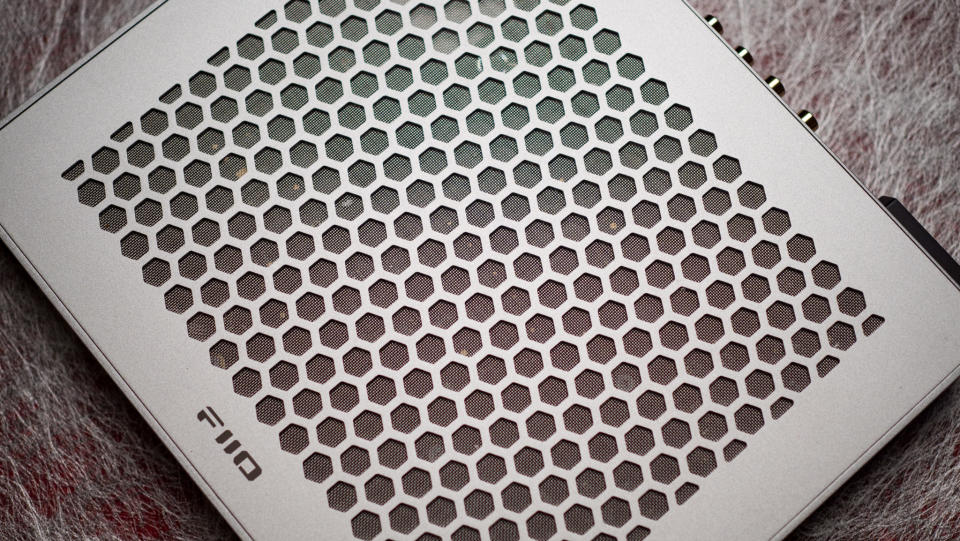
The standout design feature is the honeycomb structure that covers the top and bottom halves of the DAC; this creates a much more elegant design while increasing passive airflow to the DAC at the same time. There's a steel mesh underneath the honeycomb pattern that does a good job preventing dust ingress, and there are vents on either side that deliver airflow into the DAC.



Like the K9 Pro, the K19 is cooled passively, but the increased vents means the DAC doesn't get hot after extended use. The chassis itself is made out of aluminum, and it has a reassuring heft to it; I didn't see any issues whatsoever with the build quality, and it's clear that the K19 is designed to last decades.
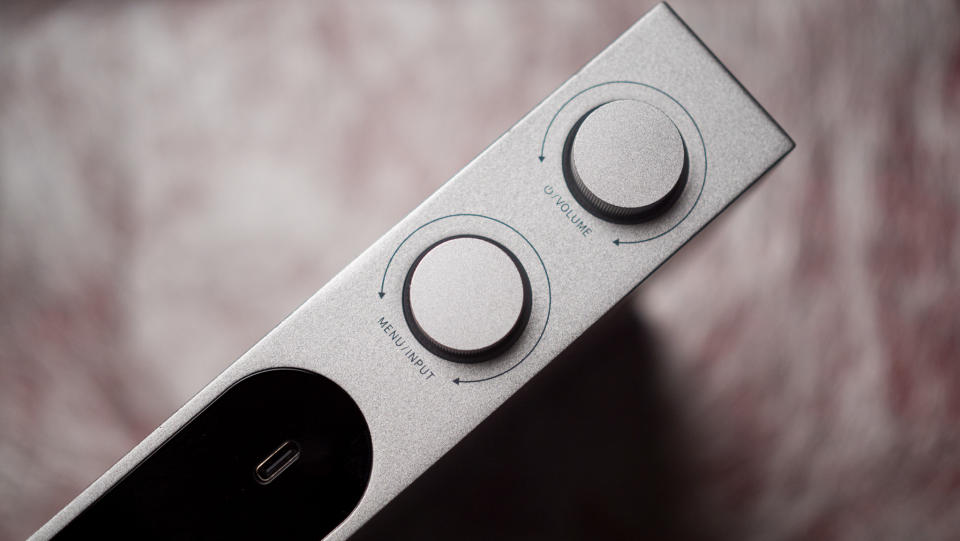
An interesting change this time is the availability of a silver color variant. It makes the K19 look that much more elegant, and gives it a presence that you just don't get with the black version. That said, the silver model is designed to grab attention, so if you want a DAC that you can tuck away unobtrusively, you should get the black model.

The model name, THX branding, and Hi-Res logo are all located on the underside, leading to a cleaner look — you just get the Fiio logo at the top. Fiio also changed the navigation, so instead of buttons, you get two rotary knobs, and a built-in 1.3-inch screen that lets you change between various modes and sources.

The screen has a TFT panel and gets bright enough, but I would have preferred a larger panel. One rotary knob is used to control the volume, with the other used to change the menu options. Both knobs have a knurled texture that makes using them incredibly easy, and they an LED ring light that changes color based on quality of playback source.

Talking about a clean design, the screen sits in an island along the front that includes all the connectivity options, and this is decked out in black, serving up a good contrast against the white chassis. As is the case with all of its products, Fiio bundles a generous amount of accessories with the K19, and the one I like the most is an acrylic cone that's designed to wedge into the side — this allows the DAC to double as a headset stand, and that's just plain cool.
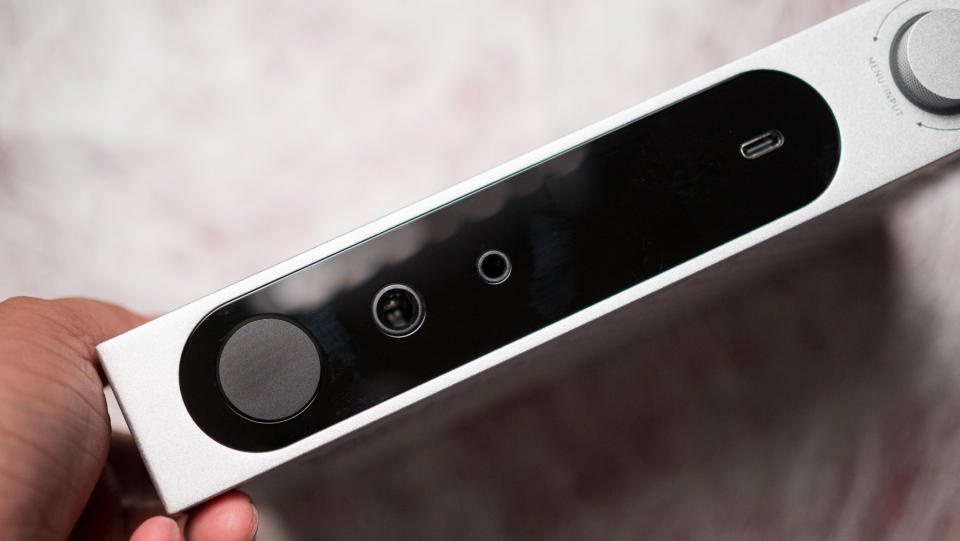
Overall, Fiio did an outstanding job with the design of the K19; the DAC looks stunning, and the changes to the passive cooling means it gets much better ventilation.
Fiio K19: Connectivity and features

Similar to the design, Fiio paid close attention to detail when it comes to the K19's feature-set, and as a result, you get what is possibly the best connectivity of any DAC. Let's start with the front: the K19 has a single-ended 6.35mm port in addition to the balanced 4.4mm port, and the 4-pin XLR port is hidden behind a dust cover. There's even a USB-C port, giving you easy access to connect to other devices.
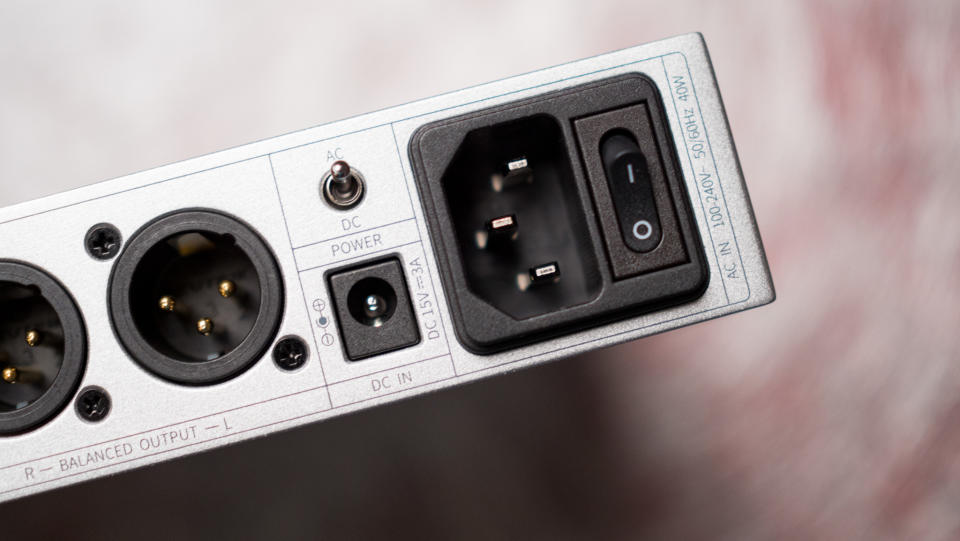
It's at the back where things get interesting. The K19 can be powered by both AC and DC sources, and there's a toggle to switch between the two. Fiio bundles an AC power cord in the box, but if you have a DC barrel plug and want to use it that way, you can do so (it uses 15V/3A).
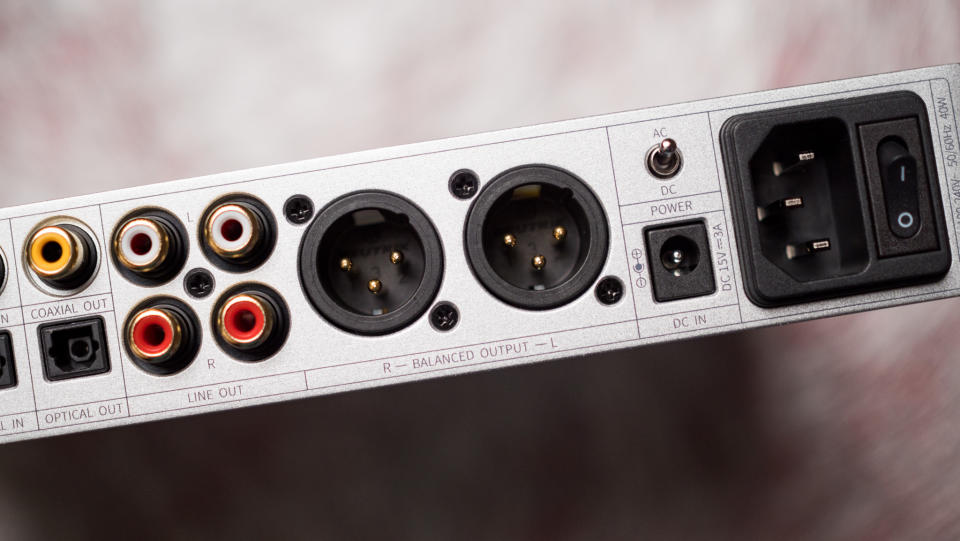
When it comes to analog connectors, you get balanced 3-pin XLR in addition to RCA, with the latter featuring dust covers. Digital connectivity is handled by optical in/out, coaxial in/out, and USB in. What's interesting with the K19 is that Fiio is no longer using the USB-B connector, instead switching over to USB-C, making it extremely easy to connect the DAC to a source device. I had no issues connecting the DAC to my Windows machine via the bundled USB-C to USB-A cable.

Fiio is using an integrated Bluetooth antenna on the K19 — just like the R7 — and it adds to the cleaner look of the DAC. The biggest change to the DAC is the inclusion of HDMI ports; you get HDMI in and HDMI ARC out, and this allows the K19 to be used with TVs and gaming consoles.

To that effect, Fiio bundles an infrared remote in the box. You can use it to change the volume, switch the K19 on or off, adjust the EQ, and change connection modes. It doesn't have backlit keys, but it offers an easy way to control the K19. Of course, if you want to use your phone, Fiio Control gives you access to all the K19's settings.
Fiio K19: Sound quality

Fiio uses dual ESS's latest ES9039S Pro DAC hardware, and it goes up to 768kHz/32-bit over PCM and DSD512 via USB. It has an XMOS XU316 USB controller, and the Bluetooth side of things is handled by Qualcomm's QCC5125 — the same as the K9. Similar to the K9 Pro, amplification is by way of THX's outstanding 8-channel 788+ modules.
What makes the K19 stand out is the sheer power on offer; it is able to deliver up to an insane 8000mW at 32Ω via the balanced ports, and that's significantly higher than what you get with any other DAC. Interestingly, the K19 has a built-in DSP engine that enables parametric EQ — accessible via Fiio's custom DSP software on Android, Windows, and macOS — that gives you granular control over the sound.

I tested the K19 with a wide range of IEMs, including Fiio's own FX15, Letshuoer Cadenza 12, Audeze Euclid, Thieaudio Prestige LTD, and a half-dozen budget models. The K19 has no problems driving sensitive IEMs, and it did a fantastic job in this regard — as you'd imagine.
I didn't run into any issues at all with headsets, and I used the likes of the Audeze MM-500, LCD-X, Fiio FT5, Moondrop Venus, and Focal Elex. There's just no scenario where the K19 doesn't deliver more than enough power, and that's just not a problem with this DAC.

Coming to the sound, the K19 has Fiio's characteristic signature, but with added vibrancy. When using the FT5 and MM-500, bass notes have good vigor and impact, with a subtle sub-bass extension that's terrific. There's better definition than the K9 Pro, and that's immediately evident when switching between the two.
The mid-range is clean and natural, and vocals have no problem shining through the mix. Instrument separation is excellent, and you can hear intricate details with ease, like the pluck of a guitar. The treble has good extension, and you get a sense of airiness that adds dynamism.
On the whole, the biggest difference over the K9 Pro is that the K19 sounds more engaging and dynamic, and you get a wider soundstage that's just enjoyable.
Fiio K19: The competition

The K9 Pro is still a stellar choice in 2024. It has a terrific sound, the design looks cool thanks to the gold accents, and you get extensive connectivity. It doesn't have any issues driving demanding planar headsets, and the sound is engaging and wide. The K9 Pro costs $849 as of writing, but it is likely to go on sale as the K19 becomes available globally. Fiio has mentioned that it will sell the K9 Pro alongside the K19, so if you don't need the extra power or some of the additional features, the K9 Pro would be the way to go.
If you want the best value, you should consider the regular K9. It has the same design as the K9 Pro, and while it doesn't feature the best ESS DACs, the tonality is remarkably close to the K9 Pro. Best of all, the K9 costs just $499.
Fiio K19: Should you buy it?

You should buy this if:
You want a high-end DAC
You need extensive analog and digital connectivity
You want a DAC with an elegant design that's built to last
You need an engaging sound with good dynamics
You shouldn't buy this if:
You need a value-focused DAC
The naming convention with the K19 suggests it is an upgrade over the K9 Pro, but it is so much more than that — this is a truly outstanding product that immediately stands out in the brand's portfolio. The design is unmistakably premium, and the white version in particular looks stunning. The ability to use it in vertical or horizontal orientation makes it that much more versatile, and the sleeker build along with all-metal chassis means the K19 is designed to last decades.
But it's the feature-set that makes the K19 so alluring; you get every single port you'll ever need, and the exhaustive connectivity combined with Bluetooth 5.1 and lossless audio codecs make this a fantastic choice when paired with just about any audio device.
Ultimately, the K19 is a halo device that solidifies Fiio's position as one of the leaders in the enthusiast audio category. Yes, it costs a lot of money, but you're getting a ton of features, and if you're after an endgame DAC that can do it all, you've just found it.
